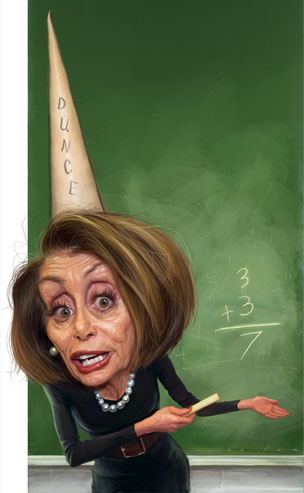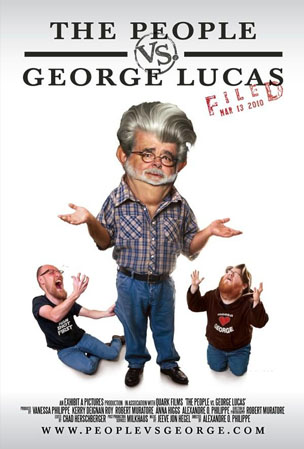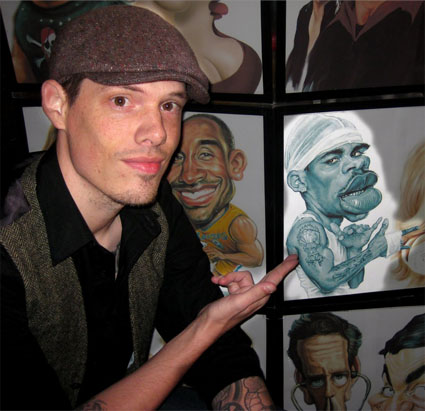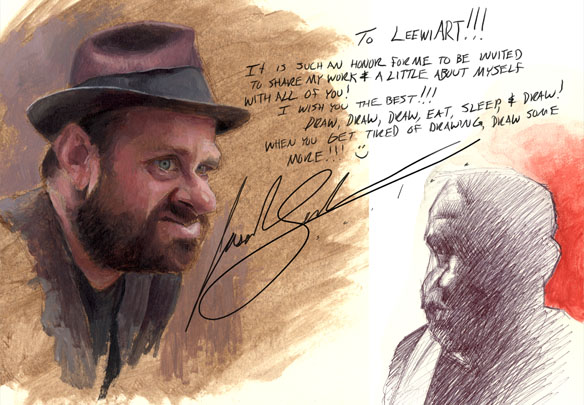Introduction
Me knowing Jason is inevitable but also coincidental. Inevitable because since my blog was set up, Jason and I often comment on each other. Jason’s works are so popular, they naturally got my attention; and every time after I commented,Jason always would reply me politely within ten minutes or so (you could tell he spends a lot time on-line, considering we live in different time zones). The coincidental part is when Jason was featrued in the magazine “#3 LIVE YOUR LIFE” and introduced to German readers, I happened to be the one who draw cover art for that issue. After that, we both memorized each other by heart.
Among my peers and friends, Jason could be the one you envy the most. Just reached his 30s, he’s almost got everthing! His client including the most famous humor magazine in USA MAD Magazine, Time Magazine, New York Times,GOLF Magazine, Guitar Player, King, The Weekley Standard and Business Week. That’s a list packed with important publications, but his achievement is beyond that. In 2008 and 2009, his personal art books Caricature the Art of Jason Seiler and SEILER 2008-2009 are released. For Jason the year of 2009 is full of rewards, he finished a two hours tutorial DVD Sketching with Jason Seiler, and besides that he also instructed an on-line caricature course for Imaginism Studios! Also in 2009, he joined the Tim Burton’s hit feature film Alice in Wonderland as character artist with Bobby Chiu, the founder of Imaginism Studios. If you really know Jason and how endeavoring and efficient he is while doing this incredible amount of works, you will agree that he earn everything he own by himself.
To me, I don’t only admire Jason’s professional successes, but also his popularity in the cyber world! Ever since Jason and I exchanged blog link, my visits has rocketed! And eight out of ten visitors must have found my blog via Jason’s. Another proof, if you search “Jason Seiler” on engines like rapidshre or hotfile, Jason’s work collection such as Funny Caricatures will always pop up within second.
Interview
Question: HaiTao SU Answer: Jason Seiler
Q:We would like to know, how you started your career, and how to go success step by step.
A:
Well, I started drawing caricatures when I was in the 5th or 6th grade, but I’ve been drawing ever since I can remember. My official career started when I was twenty, but I believe that it was only because of my determination and ambition as a young kid that I was able to start working professionally at that age.
At first, I didn’t have a website, and blogs hadn’t come into existence. There was and still is a site called The Nose, ran by Tad Barney. The Nose is a site where artist can put up a few samples of their work in hopes of getting some gift caricature work or live party work. I was also a member of the ISCA, or International Society of Caricature Artists, and their website also allows artists to post samples of their work. So between those two websites, I began to get work here and there, mostly private commissions, portraits of family members or retirement gifts. But that wasn’t what I wanted to do, not by a long shot. I wanted to be a published caricature illustrator, like Ismael Roldan, C.F. Payne, Roberto Parada and Daniel Adel. So I began to submit examples of my work to smaller magazines and papers, hoping they would use me. It didn’t take long before I was called by Cracked magazine to do a few covers for them as well as inside comic work. I also did a lot of work in those days for a small religious satire magazine called The Witten burg Door. I did 4 or 5 covers for them as well as inside work. The pay for both of these magazines was absolutely horrible. But it was work and my drawing swere being published on a regular basis. At this time I was self taught, and even though I had done work for a few magazines, some work for companies such as Kraft Foods and Universal Pictures, I felt like something was missing in my work. I decided to find a school to study painting and illustration. So I attended the American Academy of Art, located downtown Chicago. A great school, but after being there for a few years, I realized that it wasn’t making all that much sense staying in school. I did learn quite a bit about drawing and painting from life and from my anatomy classes, but my professionally work was growing and it increasingly became harder and harder balancing school work with professional work. A point was finally reached where I was having to turn down magazine work so I could go to school to get a degree in hopes of getting magazine work, this didn’t make much sense, so I quit. During my last semester at the Academy, I was asked to paint another cover for. By this time I had begun to teach myself f how to paint digitally using Photoshop. The Door had asked me to paint Napoleon Dynamite on the cover. I thought to myself that this could be a great cover for MAD magazine. And then it occured to me, to pretend that I was painting a cover for MAD magazine. I decided that I would put everything into that cover, I’d give it all I could. It was an add itude adjustment. Rather than just painting a cover for them as I had done before, I decided to approach this new cover as a way out, a way to prove myself. I found myself a model, I lit the model how I wanted, dressed the model in proper Napoleon Dynamite atire,. I also found a few props that I needed for reference and then took loads of pictures.
This was the first time I put so much effort into a piece of art, I painted for days on this one piece, getting it just right. After the job was finished and sent off, I received an email from the art director and editor saying how blown away they were. They told me that it was the best cover they’d ever had, that no one had ever put so much into a cover for them. That was really nice to hear. They were so happy, they gave me a $50 tip, which brought my grand total to a whopping $300.00.
I have never worked with The Witten burg Door since. This wasn’t my choice, they just never contacted me again. Perhaps they thought they could no longer afford me? Who

|
Napoleon Dynamite-01
|
Q:In your work, what is the greatest difficulty you encountered? How did you overcome it?
A:
The greatest difficulty that I face is time. I know that I can draw and paint anything that I want, but can I draw and paint anything I want under an extremely tight deadline? Deadlines are the devil. A lot of the deadlines for publication work that I get these days only give two to three days tops to complete an illustration, from start to finish. It would be one thing if it were just a simple portrait, but it’s never that easy. Typically there’s a story that needs to be illustrated , which means props, costumes of one form or another, and sometimes more than just one or two people as well as a background. This kind of work is not easy to tackle in only a couple days, but it’s what I deal with an almost weekly basis.
If drawing accurate, original, and humorous likenesses of people wasn’t hard enough, under such tight deadlines, you have to also realize that reference needs to be found, compositions thought out and sketched and then there’s the waiting for approval before starting the final art. Once the sketches are approved, I will shoot my own photo reference for lighting, expressions, and folds in clothing. All of this must be done very quickly…
I overcome these challenges by doing this kind of work on a regular basis. With each job I do, I learn so much, mostly how not to do something the next time around. I know the next job will easier. I also know that new challenges will present themselves, and I will have to come up with new ways to deal with them.

|
Example of one of my quick deadlines
|
Su, here is a good example of one of my quick deadlines. This painting was completed in only nine hours from start to finish. Painted for The Weekly Standard. There's a part in the interview where I talk about the difficulty of turning around tight deadlines. This would be a good example to show there.
Q:I know your father is also an artist, and he is proud of you. Could you tell us what impact he has on you?
A:
Yes, this is true, my Dad is an awesome painter. His sketchbooks were a big influence to me while growing up. I learned that even in your sketchbooks you can take pride in the work that you do. My Dad’s sketchbooks are amazing to look at. Beautiful drawings done mostly with a ball point pen, thinking of them makes me want to sketch right now. While growing up, my Dad was mostly a wildlife artist and won Wildlife Artist of the year in 1985. He taught me things from time to time, but never pushed art on me. I did that to myself. And I don’t know why, but sadly, I mostly blew my Dad off, ignoring most of what he said. I think it’s just a “kid” thing. I only wanted to draw what I wanted to draw and that was it. I wasn’t interested in learning about Values, or color, or how to mix paints and so on, I had to take it at my own pace and learn in my own way. Now every time I get together with my Dad, I try to get out of him as much as I can. I love painting with him, but I love watching him paint even more.
Q:Do you think which commercial commissioned work is the most interesting (or the most satisfying) one?
A:
Well I was very excited when TIME magazine called me to paint seven people for a small piece on the TIME 100. But even more exciting was painting a two page, full color spread for MAD magazine. That was a childhood dream come true! Recently, I was asked to paint the official movie poster for “The People VS George Lucas”, a documentary about George Lucas, directed by Alexandre Phillipe.. It’s exciting seeing the poster all over the place, but mostly I’m excited to have finally painted a movie poster, something I have always wanted to do. And even more excited that George Lucas was the subject, because not only am I a fan, but he’s one of my favorite people to draw.

|
"The People VS George Lucas".
The credit should read (c) 2010 Jason SEILER and Exhibit A Productions, LLC. All Rights Reserved
|
Q:Many readers wonder how your process of creating a caricature is.
A:
Well, this is not really something that can be explained in a sentence or two, but I will try. For me caricature is not only about exaggerating a person’s features as much as you can. This is the
beginners approach to caricature. Caricature is exaggerating the truth of what you see, but even more, it is about capturing the character and the essence of your subject. I look for unique relationships between the eyes nose and mouth, but the three most important things to get right for me would have to be the eyes, mouth, and head shape. I spend most my time getting the eyes and mouth just right, they express so much character and personality, and they’re so much fun to explore. And speaking of exploring,I tend to do a few thumbnail sketches, which give me more options to choose from. Rather than settling on my first sketch, I explore and develop the caricature, this allows me to come up with stronger caricatures.
Q:Could you show us some sketches in your creative process?
A:
Here's an original pencil drawing and a page from my sketchbook.

Q:What is the key point to capture the characters’ characteristics do you think?
A:
I think what you are asking is, How do I capture the character of a person? If so, I believe this is something that comes naturally to me. I’ve been doing caricatures and portraits for so long that that capturing the “character” of a person isn’t something I think too much about. As I said earlier, I focus on the eyes, mouth and head shape, I believe these are the most important features that you must get right in order to capture a person’s character and essence. Personality and posture are important to capture as well. I feel that capturing the personality and posture comes from the artists ability to observe other human beings.
Q:How do you handle the exaggeration extent of a character?
A:
I believe that it is important to be able to draw and paint realistic portraits with realistic proportions. It is a must to understand the human anatomy. I have studied the skull and the muscles of the face and body. It is also very important to draw and sketch as much as you can. A solid foundation in drawing is an important part of my work. I draw all the time, as much as I can anyways. The more you draw people and understand the many variations of the human face and what it can do, the easier exaggeration becomes. But the real thing one must grasp, is that exaggerating a person’s features is as simple as pushing the truth or stretching the truth. Taking what is true about a person’s face and exploiting it. I try to simplify the shapes and relationships between features that I see in my first sketch. As I develop the sketch into a drawing, I become bolder with my exaggeration.The key for me is to build the structure from the ground up, starting with a light sketch and then building everything up from there.
Q:What is your favorite subject matter of painting?
A:
Well, it’s obvious that I love painting people. I never get tired of drawing and painting people, I continue to learn so much every time I draw and paint, it’s just as exciting for me today to draw and paint as it was when I was a young kid drawing in my bedroom. My favorite people to draw and paint are not celebrities but rather “real” people that you see in your everyday life. These people are the most interesting to me.
Q:Which artists have great impact on your creativity?
A:
John Singer Sargent, Anders Zorn, Norman Rockwell, Leyendecker, Sean Cheetham, Hermann Mejia, Tom Fluharty, Sebastian Kruger, Peter De Seve, Nico Marlet,and my Dad, Larry Seiler.
Q:Compare the traditional painting tools, such as pencils, watercolor, with modern digital painting tools, such as Photoshop and other painting software, how do you think the difference between them? Which way do you prefer?
A:
Well, there is a huge difference between painting digitally and traditionally. I personally prefer to paint traditionally with water colors, acrylics and oils, then paint digitally. In fact, the main reason I paint digitally is so that I can make the insane deadlines that the editorial world expects me to make. I have learned how to paint very fast digitally, but when it comes to painting traditionally, I am much slower. Painting digitally for editorial work saves me from a lot of hassles that I would have to deal with if I were painting traditionally. Just to get the final image to the art director is an undertaking in itself. The art has to be scanned or photographed, and it never looks as good as the original. Then the art has to be color corrected and most times touched up. This is all very difficult to do under a tight deadline. Then comes the issue of making changes. A lot of times, the art director might want a change here and there. This is not a problem at all painting digitally, it’s an easy fix. But fixing a traditional painting is not an easy thing to do. Also, in my opinion, publications do not pay enough for me to paint traditionally, so all in all, digital painting makes the most sense for my editorial and illustration work.
When I paint for myself, it is almost always with oils or acrylics. I love painting with oils, there’s so many ways of using the medium, so many different surfaces you can paint on, there’s nothing like it. I also really love painting with watercolors.
I was taught traditionally so it is important to me that my digital work has a traditional look to it. I prefer this over work that looks too digital. The way that I do this is by painting digitally in a more traditional way. I paint most times with a limited palette, with the same sort of colors I tend to use when painting traditionally. I also make sure that I’m not abusing what a computer can do. I don’t get into using the different tricks that photo shop has to offer, such as the warp tools and so forth. As much as I can, I try to just draw and paint as raw and real as I can.

Q:I see you are using WACOM LCD touch screen drawing; please tell us how you feel to use this expensive tool.
A:
Well first off, it’s not all that expensive if you are a working professional. If you are a working professional and you’re serious about what you do, then I believe that the Contiq is a must.
For many years, I used a Wacam Intuos tablet which worked very well. But when I finally bought my Cintiq, I wondered how I could have worked so long using a tablet? I was able to pay for my Cintiq with the fist job I did with it. The Cintiq is awesome. As my friend Bobby Chiu says, it’s like “Magic Paper”. It feels way more natural drawing and painting using a Cintiq than it does using a tablet. Simply because you are drawing and painting on the surface as you would if you were drawing or painting traditionally. If feels more natural. What else can I say? I love my Cintiq.
Q:Your works are so excellent, and so many people like them. But we wonder whether you encountered people who don’t like them and how did you deal with it?
A:
I’m sure there are people out there who can’t stand my work. I haven’t met anyone yet, but I’m sure they exist. Do I care? No, not really. I don’t draw and paint to be cool, or popular. I draw and paint for myself and my family, and for the art directors who hire me. I don’t believe that I have it all figured out, and to tell you the truth I barely like anything that I do. I continue to push myself and to grow as an artist, I try not to look back too much, only to see how far I’ve come. If someone doesn’t like my work, they don’t like my work. That is fine with me.
Q:In your country, what’s the status of caricature artists? Will it be limited in some ways?
A:
I think that Caricature comes and goes like trends or fads. One year, every magazine will be using caricature and the next only a few. I have experienced a steady flow of work for the last five years and I am extremely grateful for that. The one thing that I think may be different in America vs. other countries that use caricature work, is that in America, exaggeration has its limitations. With the exception of maybe Steve Brodner, the work of most successful published caricaturists, is closer to portraiture than caricature. Daniel Adel for example is very well known and is very talented. But to me his caricatures are portraits with little bodies. This type of caricature is more welcomed in American publication because the person is immediately recognized, and a lot of editors I believe are afraid of offending readers or whoever the subject of the caricature is. I try to get away with as much exaggeration as I can, but only to separate myself from other caricaturists. I want my work to stand out, to be unique and different, and that is something that I work on.

Q:I know you are involved in the concept design of Tim Burton’s new movie Alice in Wonderland 2010.Could you show us some works?
A:
Yes, I was involved, but nearly two years ago. I worked with my friends Bobby Chiu and Kei Acedera at Imaginism Studios. I worked on characters such as the Tweedles, the Red Queen, the March Hare, the Bandersnatch and the Executioner. I cannot share any of the work here, but you can see the work as well as information about the creation of the work on my blog. http://www.jasonseilerillustration.blogspot.com
Q:Could you introduce your current new project?
A:
As I mentioned earlier, I recently painted the official movie poster for the documentary “The People VS George Lucas”. I also recently painted a book cover for Penguin Group Publishing that won’t be published until December of 2010. Currently I am working for magazines such as The Weekly Standard, Wall Street Journal, and Village Voice. As a freelance illustrator, you never know when or where the next job will come from. I am also working on many new illustrations for myself, as well as fine art oil paintings for gallery shows.
Q:What’s your suggestion for those who want to engage in caricature? How to become a successful caricature artist?
A:
I would suggest that you draw as much as you can, and not just people. Study and observe everything. Learn how to draw people realistically, understand the skull and anatomy of the human face. Have fun, enjoy it, and it will show in your work. Remain humble and teachable, you’re always going to have something to learn, and areas that need improving, no one has it all figured out. Even Sebastian Kruger who is known worldwide for being the ultimate master of caricature, continues to grow and improve. For an example of this, compare his earlier work featured in his first two books, “Stars and Stones” to the work he is creating today. His past work, in my opinion is no where near as amazing as what he is now drawing and painting.
Q:If possible, would you like to publish your art books in China?
A:
That would be great, are you offering? :)
Q:Please write a sentence with your signature for China’s fans!
A:
My friend, I want to thank you for giving me such a rare opportunity to you and your excellent works introductions to the Chinese all the fans!
This interview will be held April 02, 2010 published in the www.leewiart.com site and permanently retained in this!
